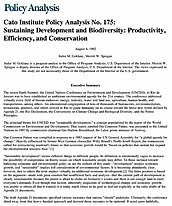The principal theme for UNCED was “sustainable development,” a concept popularized by the report of the World Commission on Environment and Development. That report, entitled Our Common Future, was presented to the United Nations in 1987 by commission chairman Gro Harlem Brundtland, the Labor prime minister of Norway.
Our Common Future was compiled in response to a 1983 request of the UN General Assembly for “a global agenda for change.” Heavily influenced by former West German chancellor Willy Brandt’s North-South Report, the commission called for restructuring mankind’s future so that economic growth would be “based on policies that sustain but expand the environmental resource base.”[1]
“Sustainable development” means different things to different people. Its definition is intentionally vague to increase the possibility of compromise on thorny issues on which reasonable people may differ. To those inclined toward balancing economic and environmental goals–as are the authors of this study–“development” implies economic growth, and “sustainable” implies full consideration of environmental factors. It is becoming abundantly clear, however, that to others the term implies virtually no additional economic development.[2] The latter position is based on the argument–made with great emotion but insufficient facts and analysis–that the current path of development is clearly unsustainable because the planet is about to choke on humanity’s wastes and there is not enough land to meet everyone’s demands. Even though that faction, inherently suspicious of technological change and economic growth, was unable to obtain all that it wanted, it is today much closer to its goal as laid out explicitly in the early drafts of the Agenda 21 documents.
The draft Agenda 21 documents specified various measures that nations “should” undertake. Ultimately, the conference shied away from that heavy-handed approach and decreed those measures to be optional. If acted upon faithfully, many of those measures would impose national planning on virtually every economic sector, regulate almost all human activity, and subordinate all social and economic goals to environmental goals. Thus, while calling for a massive transfer of wealth and technology from developed to developing nations, the recommended measures would deny all nations the means of creating more technology and wealth by putting in place legal and institutional frameworks that would be incompatible with either technological progress or economic growth. Proponents of those measures, in part because of their refusal to balance environmental and socioeconomic goals, would needlessly reduce agricultural productivity in the name of sustainability–even as they lament that the world has too many people to feed and that agriculture uses too much land and denudes forests, thereby threatening species and reducing biodiversity. Such measures, in addition to being poor social and economic policy, would be counterproductive; they would cause more environmental harm than good, and they might even bring about the very catastrophe environmentalists strive to avert.
In particular, the Convention on Biological Diversity, which the United States rightly refused to sign, does not even address the single most important reason for the loss of biological diversity and deforestation: the loss of habitat and land conversion to meet fundamental human needs for food, clothing, and shelter. Moveover, the convention would reduce the incentives to research and develop the very technologies that would–if anything could–help meet the competing demands made on land by human beings and other species.
Using as an example the historical increase in U.S. agricultural productivity, this study will show that–but for technological progress–all our forestlands and croplands, including those that would have been only marginally productive, would have had to have been plowed to produce the quantities of food we produce today. The accompanying wholesale destruction of forests and other natural habitats and the reduction of biodiversity would have resulted in environmental problems that would have dwarfed those we face today and matched environmentalists’ worst nightmares.
The only way to feed, clothe, and shelter the greater world population that the future will inevitably bring–while limiting deforestation and loss of biodiversity and carbon dioxide sinks–is to increase, in an environmentally sound manner, the productivity of all activities that use land.[3] Such increases are possible only within a legal, economic, and institutional framework that relies on free markets, fosters decentralized decisionmaking, respects individual property rights, and rewards entrepreneurship. Such an approach is the best hope for a world facing severe pressure on its land base, yet it has been noticeably absent from recent, much-publicized strategies that purport to lead us to sustainable development, conserve biological diversity, and combat global deforestation.

